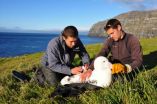(Press-News.org) LIVERMORE, Calif. --There are more exoplanets further away from their parent stars than originally thought, according to new astrophysics research.
In a new paper appearing in the Jan. 12 edition of the journal, Nature, astrophysicist Kem Cook as part of an international collaboration, analyzed microlensing data that bridges the gap between a recent finding of planets further away from their parent stars and observations of planets extremely close to their parent star. The results point to more planetary systems resembling our solar system rather than being significantly different.
Gravitational microlensing occurs when light from a source star is bent and focused by gravity as a second object (the lens star), which passes between the source star and an observer on Earth. A planet rotating around the lens star will produce an additional deviation in the microlensing. The first gravitational microlensing observations were made by the Massive Astrophysical Compact Halo Object (MACHO) collaboration, led by Livermore scientists.
The new research also determines that a large fraction of planets have orbital distances from 0.5 to 10 sun-Earth distances. In the past, using the Doppler shift technique, most extrasolar planets found were gas giants like Jupiter and Saturn that orbited stars that were much closer to them than the sun is to Earth.
An exoplanet is a planet outside our solar system. Over the past 16 years, astronomers have detected more than 700 confirmed exoplanets and have started to probe the spectra and atmospheres of these worlds. While studying the properties of individual exoplanets is undeniably valuable, a much more basic question remains: how commonplace are planets in the Milky Way?
The team found that approximately 17 percent of stars host Jupiter-mass planets. However, cool-Neptunes and super-Earths are more common, occurring 52 percent and 62 percent, respectively, of the time.
Gravitationally microlensing is very rare. In fact, fewer stars than one per million undergo micolensing at any time.
The team's result is consistent with every star of the Milky Way, hosting, on average, one planet or more in an orbital distance range of 0.5 to 10 sun-Earth distances.
"Our measurements confirm that low-mass planets are very common and the number of planets increases with decreasing planet mass, in an agreement with the predictions of the core accretion scenario of planet formation," Cook said. "Planets around stars in our galaxy appear to be the rule rather than the exception."
"We used to think that the Earth might be unique in our galaxy. But now it seems that there are literally billions of planets with masses similar to Earth orbiting stars in the Milky Way," concludes Daniel Kuba, of the European Southern Observatory and co-lead author of the paper .
###
Founded in 1952, Lawrence Livermore National Laboratory (www.llnl.gov) provides solutions to our nation's most important national security challenges through innovative science, engineering and technology. Lawrence Livermore National Laboratory is managed by Lawrence Livermore National Security, LLC for the U.S. Department of Energy's National Nuclear Security Administration.
END
The ability to catch international smugglers and terrorists just got upgraded with a Jan. 12 demonstration of collaborative software funded by the Office of Naval Research (ONR).
The Mission-Focused Autonomy (MFA) program was put into practice for the Joint Interagency Task Force (JIATF) South in Key West, Fla., during an exercise dubbed "Marathon." The collaborative information discovery and knowledge-sharing tools sift through government agency databases to support efforts by federal law enforcement for information on foreign nationals intent on harming national security ...
Paris/ Leipzig. Wandering albatrosses have altered their foraging due to changes in wind fields in the southern hemisphere during the last decades. Since winds have increased in intensity and moved to the south, the flight speed of albatrosses increased and they spend less time foraging. As a consequence, breeding success has improved and birds have gained 1 kilogram. These are the results of the study of an international research team published in the latest issue of the Science journal. However, these positive consequences of climate change may last short if future wind ...
A Rice University laboratory has found a way to turn common carbon fiber into graphene quantum dots, tiny specks of matter with properties expected to prove useful in electronic, optical and biomedical applications.
The Rice lab of materials scientist Pulickel Ajayan, in collaboration with colleagues in China, India, Japan and the Texas Medical Center, discovered a one-step chemical process that is markedly simpler than established techniques for making graphene quantum dots. The results were published online this month in the American Chemical Society's journal Nano ...
Deaf people who use sign language are quicker at recognizing and interpreting body language than hearing non-signers, according to new research from investigators at UC Davis and UC Irvine.
The work suggests that deaf people may be especially adept at picking up on subtle visual traits in the actions of others, an ability that could be useful for some sensitive jobs, such as airport screening.
"There are a lot of anecdotes about deaf people being better able to pick up on body language, but this is the first evidence of that," said David Corina, professor in the UC ...
A new UC Davis study shows how the brain reconfigures its connections to minimize distractions and take best advantage of our knowledge of situations.
"In order to behave efficiently, you want to process relevant sensory information as fast as possible, but relevance is determined by your current situation," said Joy Geng, assistant professor of psychology at the UC Davis Center for Mind and Brain.
For example, a flashing road sign alerts us to traffic merging ahead; or a startled animal might cue you to look out for a hidden predator.
When concentrating on a specific ...
PITTSBURGH—Determining the evolution of pigmentation patterns on mollusk seashells—which could aid in the understanding of ancient nervous systems—has proved to be a challenging feat for researchers. Now, however, through mathematical equations and simulations, University of Pittsburgh and University of California, Berkeley, researchers have used 19 different species of the predatory sea snail Conus to generate a model of the pigmentation patterns of mollusk shells.
"There is no evolutionary record of nervous systems, but what you're seeing on the surface of seashells ...
CORVALLIS, Ore. – A recent study at Oregon State University found that the chlorophyll in green vegetables offers protection against cancer when tested against the modest carcinogen exposure levels most likely to be found in the environment.
However, chlorophyll actually increases the number of tumors at very high carcinogen exposure levels.
Beyond confirming the value of chlorophyll, the research raises serious questions about whether traditional lab studies done with mice and high levels of toxic exposure are providing accurate answers to what is a real health risk, ...
Vaccination with the anthrax capsule—a naturally occurring component of the bacterium that causes the disease—protected monkeys from lethal anthrax infection, according to U.S. Army scientists. The study, which appears in the Jan. 20th print edition of the journal VACCINE, represents the first successful use of a non-toxin vaccine to protect monkeys from the disease.
Bacillus anthracis, the bacterium that causes anthrax, is recognized as one of the most serious bioterrorism threats. It produces three main components that allow it to do harm—lethal toxin, edema toxin, ...
Since the discovery of the microscope, scientists have tried to visualize smaller and smaller structures to provide insights into the inner workings of human cells, bacteria and viruses. Now, researchers at the National Institute of Arthritis and Musculoskeletal and Skin Diseases (NIAMS), part of the National Institutes of Health, have developed a new way to see structures within viruses that were not clearly seen before. Their findings are reported in the Jan. 13 issue of Science.
Cryo-electron microscopy (cryo-EM) is a technique that allows scientists to image very ...
Bethesda, MD—New research published online in the FASEB Journal (http://www.fasebj.org) suggests that the types and levels of bacteria in the intestines may be used to predict a person's likelihood of having a heart attack, and that manipulating these organisms may help reduce heart attack risk. This discovery may lead to new diagnostic tests and therapies that physicians use to prevent and treat heart attacks. In addition, this research suggests that probiotics may be able to protect the heart in patients undergoing heart surgery and angioplasty.
"Our discovery is a ...

